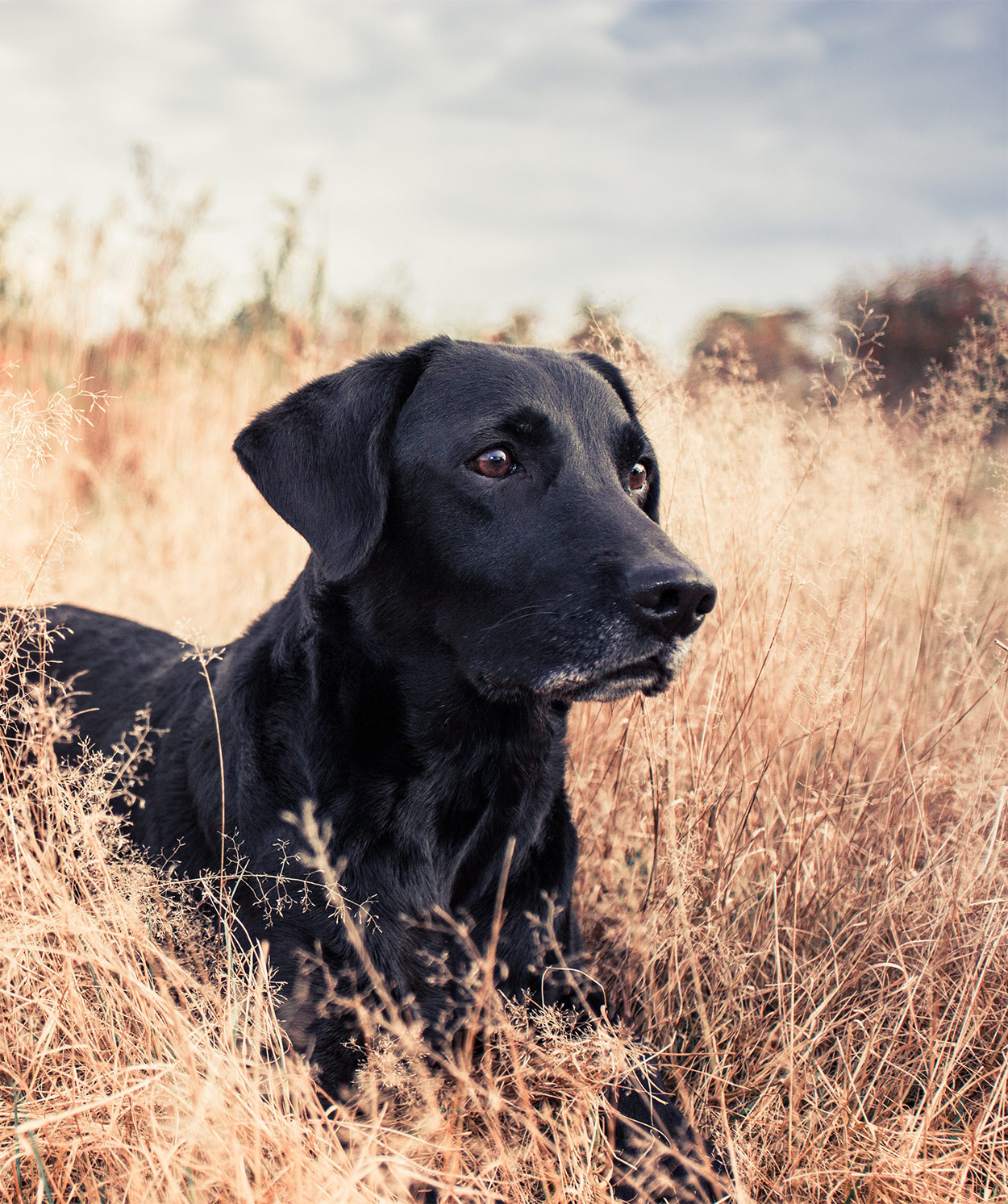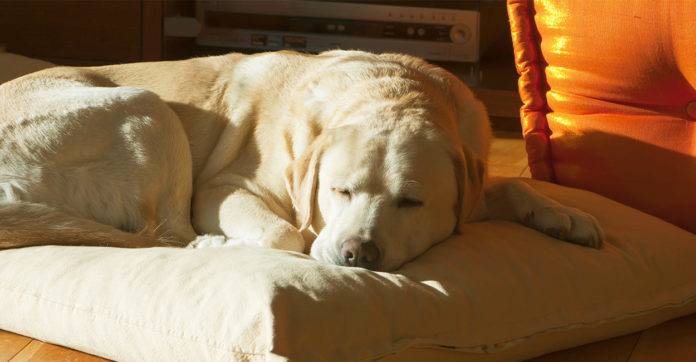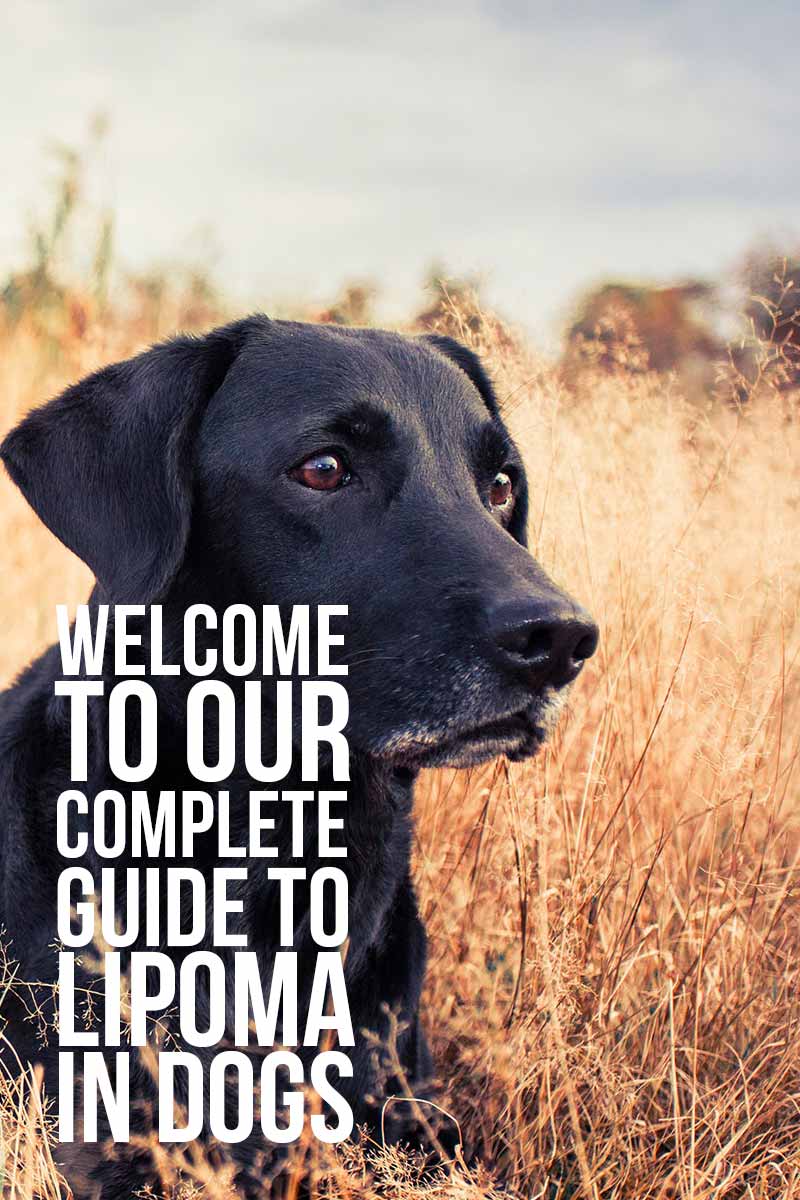Lipoma in dogs is the medical term for a benign, fatty tumor. The lump sits in the subcutaneous tissue, and if you feel it the texture is soft, smooth and slightly squishy under the skin. Your dog’s lipoma might look worrying, but it is likely harmless, painless and only an issue on a cosmetic level. Your old dog might end up with multiple lipoma tumors but continue to live and happy, health life. The only dangerous lipoma in dogs is one which is in an area like the throat or on a joint, where it might cause problems. An infiltrative lipoma can also spread rapidly and enter muscular tissue, restricting movement. Canine lipoma symptoms are more likely in overweight, senior female dogs over the age of six. However, they can occur any time from puppyhood onwards.
Contents
- What are the signs of lipoma in dogs?
- Why do some dogs get lipomas?
- Canine lipoma diagnosis.
- Can you remove a dog’s lipoma?
One morning you’re petting your pup and you discover a lump just underneath his skin. Your mind immediately jumps to the worse. You rush off to the vet and discover that your dog has lipoma. Your vet doesn’t seem worried, but what exactly does this diagnosis mean? Is it something you should be worried about, or can you be as carefree as your vet?
Lipoma Symptoms in Dogs?
Usually, the only symptom of lipoma in dogs is noticing the actual lump beneath the skin. Most lipomas are soft and slightly moveable under the skin. They feel like fatty masses beneath the dog’s skin. Usually, your dog will not exhibit any signs of pain or immobility unless the tumor is located in a joint. Furthermore, this discomfort usually does not happen until the lipoma has reached a moderate size.
Most commonly, these lumps are located on the fattiest areas of the dog, such as the belly and trunk. However, they can appear everywhere and usually appear in increasing numbers. A dog with one lipoma will probably develop another one eventually. This is not because lipomas are caused by a disease or are spreading around the body. It is simply that if the dog is genetically dispositioned to get one lipoma, they are likely to get another.
Causes of Lipoma in Dogs
The exact cause for these fatty growths is unknown. It is assumed that some dogs are simply genetically dispositioned to develop them. Often times, it is noticed that if your dog’s parents had lipoma, they are also likely to get it. However, like previously mentioned, overweight dogs are also more likely to get lipoma. Because of this, keeping your dog at a healthy weight can sometimes prevent a lipoma from forming.
Still, any dog can get lipoma, no matter their weight, breed, or gender. So ensuring that your pet is at a healthy weight will not always prevent these fatty tumors from forming.
Diagnosing Lipoma in Dogs
Diagnosis of lipoma is extremely important. Just because your dog has something that appears to be lipoma, doesn’t mean he or she actually does. There are various dangerous tumors that are similar to lipoma. It is important that these tumors get treatment right away. This is why it is always extremely important to get your dog diagnosed by a vet.
Often times, simply feeling the tumor is not enough to decide if it is simple lipoma or something more serious. On top of a complete physical exam, the vet will also need to extract some of the tumor with a fine needle. This small extraction can then be used to determine the type of tumor.
Usually, when a vet is physically examining a canine that is suspected to have lipoma, they find multiple masses. This is very common. However, each mass will need to be tested individually to ensure that they are all, in fact, lipoma.
If the fatty mass is in a joint or dangerous location, the vet might follow up the initial testing with a CT or MRI. These tests will allow for a better view of the tumor. This allows the vet to decide the best course of action in your pup’s care.
Infiltrative Lipoma in Dogs
Infiltrative lipoma in dogs is simply a special subclass of lipoma. Instead of sitting harmlessly just under the skin, these tumors invade the muscle tissue and face of the dog. In other words, they literally grow into the muscles and surrounding tissue. These lipoma are not always dangerous and sometimes do not cause any problems at all. However, due to their tendency to invade and restrict a canine’s movement, they might need to be removed.
Dog Lipoma Treatment
Most lipomas are completely harmless and only cause cosmetic issues. However, some lipomas might need to be removed based on location. These locations include places like the joints, neck, and spinal column. In these cases, dogs often show other symptoms depending on the specific location. For example, one study found that lipomas in the spine can cause paralysis. Another noted that a tumor near the trachea caused coughing and difficulty breathing.
In nearly all cases, a vet might recommend surgery to remove the mass. Luckily, these surgeries are often times very successful, with 67% of dogs remaining disease-free for at least a year after the surgery. The success of the surgery depends partially on how defined the tumor is. Tumors that are more defined and separated from the surrounding tissue are easier to remove. Tumors that are in fatty areas of the dog, such as the stomach, are usually less defined than those located in joints and leaner areas.

The Labrador Site Founder
Pippa Mattinson is the best selling author of The Happy Puppy Handbook, the Labrador Handbook, Choosing The Perfect Puppy, and Total Recall.
She is also the founder of the Gundog Trust and the Dogsnet Online Training Program
Pippa's online training courses were launched in 2019 and you can find the latest course dates on the Dogsnet website





















My lad/ wiemriner is 12 and he has a lot of tumors. He has a large one ob his lower body by jus stomach. It is 4×4 and getting larger. The vet says if you can grab it and move around it is not cancer. I did have a smaller 1 removed last yr on his back leg . If putting him on a diet to se rd if they go away would b rd wonderful. He weighs 102lbs. I only five him 2 cups per day. I’m taking him to vet this month for some annual shoys I will ask th rd vet again about what he thinks and ask the cost and th e risk or about the diet. He is still active and loves to run with my other lab. Thanks for the rd ibfo..
Thank you so much for taking the time to forward this information; so informative. I have a lab since puppy hood who is turning 11 years old and my vet found several masses upon yearly physical. I am watching and taking pictures to keep some kind of track on changes, etc. She does fit the criteria for Lipoma. I have her on Taste of the Wild now (salmon) and the vet told me not to change her diet. Thank you again so much for your expertise. Flora Wheeler for “Kimmie”.
Both of the labs I’ve had were bumpy as they got older. One female and one male and both have had mostly fatty tumors. However the male has had two supposedly cancerous bumps we’ve had removed. They are easy to distinguish because they are hairless and red. The look like they mean business. The recovery time for removal can be lengthy if you’re careful with the wound
This was an amazing read ! Thanks so much
Our lab is 13 and has several. When he first got one the vet did a biopsy on it to make sure it wasn’t cancer. That one has gotten HUGE the others still small, I feel like the biopsy “awakened” that one, its probably 8 lbs now. But he is still so full of life, sometimes acting like a puppy.
I have a whippet mix. He is about 60 lbs. He is slim and trim. He has always been this way. He has so many lipomas I can’t keep up. He had a few removed a few years ago. I think I it was less then $200. We live in Georgia. Now he is 12 going on 13 and surgery isn’t an option. I think I he could be part lab and whippet. I’m not sure his back ground. He is a rescue. His first lipoma removal was when he was about 2 years old.
Can amyone recommend vet in Minneapolis area for lipoma removal for my lab? Thank you
I would say the cost is off as well. In WI just had a quote for lipoma surgery on my 75lb lab. One lump about 5″ L x 3″ W (belly) surgery cost is $1,500-$1,900 if we also remove a second smaller lump found near ribs (about 2″ round) it would add another $500-$600. That was without CT Scan as my doctor did not say it was necessary for my dog’s operation.
I was just quoted about the same. Did you do the surgery?
My older male cattle dog had multiple large lipomas on his sides. He was also overweight. I put him on a weight management dog food. In 5 months, he is slim and trim again and all the lipomas are gone. Gone!
Can I ask…Are you saying that the ones he did have actually disappeared? And if that is so, how many did he start with? I ask because I have a 6 yo male lab and he is husky, but not what I would consider fat, but if weight loss worked for your dog, there is no harm in trying with him.
So with weight loss these can go away?
Omg. I don’t even have a 100$. So he has to suffer this on top of all the old age stuff he’s going through. Idk if I can watch him go through anything else. He’s not ready to put down yet.
Your cost estimates are a little off. Our dog is at the vet having lipoma surgery at this moment. CT scan to assess extent of lipoma -$1,200. Surgery – $2,800 – $3;800.